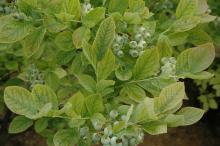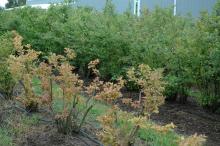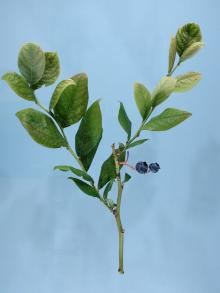Cause A soil pH of 4.5 to 5.5 is optimum for blueberry production. Soil pH values significantly outside of this range are associated with a variety of problems. Surveys indicate this as one of the more important problems throughout the blueberry industry. Iron deficiency symptoms are common since iron is less available for plant uptake at high soil pH. High soil pH may occur when a new blueberry field follows other crops that have required the addition of agricultural lime. Some research indicates iron deficiency occurs when urea is applied in limed soil, resulting in an increase in rhizosphere pH. Using lime-containing materials, such as some livestock manures, for blueberry production can also induce high soil pH.
In areas west of the Cascade Range, the native soil pH is usually acidic. Low soil pH; however, can also be a problem. At low soil pH, soil aluminum becomes more available, which impedes plant uptake of nitrogen and phosphorus, and possibly iron uptake as well. Low soil pH is often a result of soil acidification caused by nitrogen fertilizer application over time. The overdose of sulfur during soil acidification can also yield low soil pH.
Symptoms Iron deficiency symptoms include stunted plant growth and interveinal chlorosis of leaves. (Leaves turn yellow or redden between the veins.) Plants exhibit general decline in growth with red or yellow to pale leaves, low vigor and low yield. Other nonspecific nutrient or disease problems may occur due to improper soil pH.
Cultural control It is important to monitor and keep a record of soil pH on a yearly basis and take corrective actions if necessary.
- Plant hydrangeas at the end of blueberry rows to monitor soil pH. Many cultivars have blue flowers when soils are in the correct pH range. Flowers turn purple to pink as the pH increases beyond the optimum range for blueberries. Avoid white cultivars or ones that are bred to be pink all the time.
- Locate new blueberry plantings on soil that is near or within the correct pH range of 4.5 to 5.5.
- Adjust soil pH before planting with lime or sulfur-based on soil test results.
- Sulfur at 1 ton/A would be needed to lower a pH 6 clay loam soil to 4.5. Although this rate is fine before planting, once blueberries have been planted, use no more than 200 to 400 lb/A at any one time. Changes in soil pH will be slow and may take up to a year for results to show in soil tests.
- Use ground limestone if soil pH is below 4.0.
- Use ammonium sulfate as a nitrogen source especially if soil pH is on the high side. Repeated use can lower soil pH below the optimum range. Home gardeners should use products marketed as azalea, camellia and/or rhododendron food.
- Use urea instead of ammonia sulfate under low soil pH.
- Increase soil organic matter to reduce free soil aluminum under low soil pH.
Reference Haynes, R.J., and Swift, R.S. 1986. Effect of soil amendments and sawdust mulching on growth, yield and leaf nutrient content of highbush blueberry plants. Scientia Horticulturae 29:229-238.




